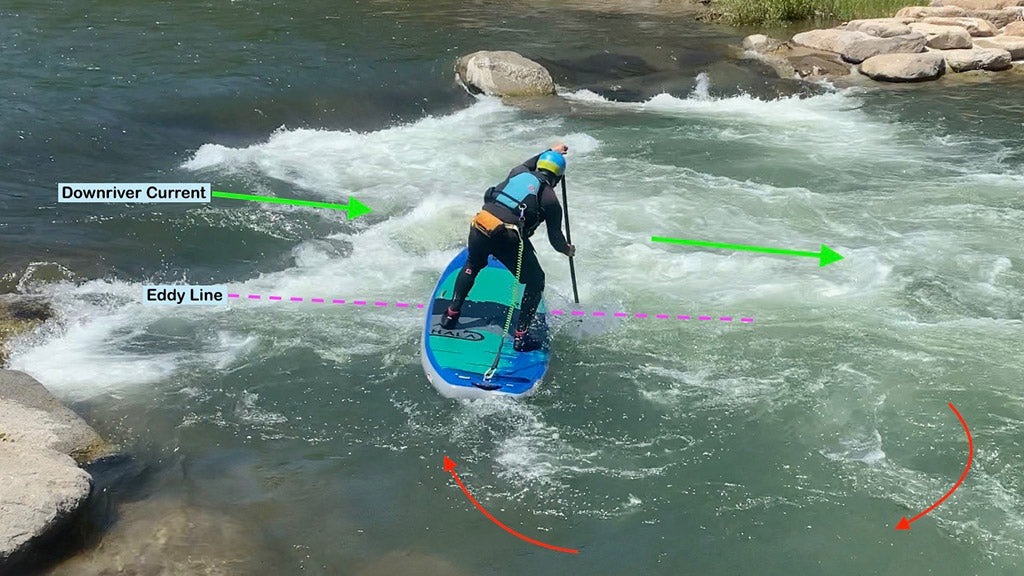We aren't going to lie, we are baffled sometimes how one stretch of water, be it in a river, or even a bay during a tide swing, can have completely different speed and dynamics than something mere feet away. And we are also always looking to understand the waters as best we can for safety...and let's be honest, speed!
So if you have ever been curious about eddies, where to be, and where not to be when you are paddling in certain directions, this article is for you. We reached out to Davide Sartoni, who's experience and understanding of River SUP and water dynamics blows our mind. Enjoy!

Understanding Eddy Currents in Rivers
As a river flows past an obstruction, water backfills the space downriver of it, forming an Eddy. Whitewater paddlers often use eddies for scouting, regrouping, and resting spots while systematically moving down rapids. Eddies are also used as safer areas to recover swimmers and equipment during a rescue. In order to effectively and safely move in and out of eddies, paddlers need to better understand the hydrology of these features.
Eddy Hydrology
The area inside an eddy can be broken down into three zones based on the movement of the water:
- Filling zone. This is where the water that backfills the eddy from the main downriver current circulates in an upstream direction towards the “top” of the eddy – the most upstream part of the eddy located just below the obstruction that creates it. The flow is often stronger on the outside perimeter of the eddy closest to the shoreline.
- Standing zone. This is where the water is standing relatively still, often in the center of the eddy.
- Flushing zone. This is where the water flushes out at the bottom of the eddy and flows in a downstream direction.
When first learning how to identify the flow of water inside an eddy, it is helpful to observe the movement of bubbles, foam, or debris on the surface of the water.
Another important element of an eddy is the Eddy Line, the boundary that separates an eddy from the main current moving downstream. Eddy lines tend to be narrower and better defined near the top of the eddy. The further downstream from the top of the eddy, the ‘mushier’ and less defined the eddy line becomes. Well defined eddy lines are visible on the surface of the water angling back towards the main downriver current from the top of the eddy. In areas of higher gradient, where the river current moves faster around an obstruction, there is a greater current differential between the flow of water in an eddy (circulating upstream) and the flow of water in the main current (moving downstream). As the current differential increases, the eddy line becomes more turbulent. In large volume rivers with gradient, eddies are often guarded by eddy lines sporting impressive ridges of water.
Eddy Hydrology

Eddies also form behind isolated obstructions in the middle of the river. The downriver current flows around the obstruction and backfills the space behind it from both sides. This results in two eddy lines, one on either side of the obstruction, and mirroring eddy currents that circulate water towards the center of the eddy in an upstream direction.
Mid-river Eddy

Paddling Across Eddy Lines
Turning into an eddy from the main downriver current is called an “eddy turn”. Experienced paddlers know to cross the eddy line near the top of the eddy where the eddy line is narrower and well defined. Here the current differential is greatest, and the conditions are optimal for fast, snappy eddy turns. Aiming for the top of the eddy also reduces the chances of drifting in the downriver current and missing the eddy altogether.
Eddy Turn - edging upstream

Once inside an eddy, paddlers using eddies to regroup should move to the standing zone. Here they will expend the least amount of energy to remain in the same spot while waiting for their group members.
Once ready to exit an eddy back into the main downriver current, paddlers can either move to the flushing zone or, better yet, they can use the upstream momentum of the eddy current in the filling zone and “peel out” across the eddy line near the top of the eddy.
Peel Out - edging downstream

When crossing eddy lines, a whitewater paddler moves from water flowing in one direction, to water flowing in the opposite direction. This is a vulnerable situation that can result in a capsize and/or swim for less experienced paddlers. In order to be successful, anticipate the change in direction of the flow of water and aggressively lean in the direction the water is flowing towards. The act of leaning/pressuring the edge or rail of a water craft is called “edging”.
The timing of the edging is also important. During an eddy turn from the main current into an eddy, wait until ⅓ to ½ of the craft crosses the eddy line before edging onto the upriver side (here the paddler is entering water circulating in an upstream direction). When peeling out of an eddy into the main downriver current, begin edging the downriver edge/rail during the set up and maintain pressure throughout the turn (here the paddler is entering water flowing in a downstream direction). Bracing with a paddle on the edging side helps leaning and pressuring the edge/rail of the water craft.
“Angle” and “speed” are also important. ‘Squaring up’ so the water craft crosses at an angle that is perpendicular to the eddy line is recommended, while carrying speed reduces the likelihood of stalling in an eddy line.
Eddy turns and peel outs should initially be practiced in whitewater that is well within the paddler’s abilities. Working out the correct timing and intensity of the edging can be tricky and can often result in swims. Look for eddies with safer runouts and free of downstream hazards. Once a paddler’s skills develop, he/she can choose more challenging eddies to practice on.
If you spend some time observing experienced whitewater paddlers, you will often notice them hopping gracefully from one eddy to another while moving down rapids. This is called “eddy hopping”. It often becomes a game paddling groups engage in as a way to practice and refine skills. Before entering an eddy occupied by other paddlers, be sure there is enough room for you, otherwise seek one that is less crowded. Before exiting an eddy, always look upstream to prevent cutting off other paddlers. Remember, downstream traffic always has the right of way!
Written by Davide Sartoni – The River SUP Guy
Team Writer Davide Sartoni (aka The River SUP Guy) - I was first introduced to Stand-Up Paddleboarding on the crisp, blue waters of Lake Tahoe, and was captivated from the very first paddle stroke. When I later discovered that I could take a SUP down a river my life was literally turned upside down. The exhilarating feeling of shredding rapids on a SUP has become my greatest obsession! I now spend over 100 days a year river SUPing, rain, snow or shine. I offer river SUP instructions in northern Nevada and northern California and guided river trips in exotic destinations worldwide. I am a certified river SUP instructor with the American Canoe Association and I am also certified in Swift Water Rescue and as a Wilderness First Responder. [ http://theriversupguy.com ]

If you have an idea for Davide to write about or any questions, send it our way and we will pass it along!
















Laiba - October 19, 2025
Excellent 👍🏻
John Barbuto - October 19, 2025
Hi. I am not an experienced paddler, but I am an experienced scientist. I was recently paddling (as a novice) on the Payette river. Indeed, I did find the eddies tricky – more than I expected. But, I had the strong feeling that the cause of being tricky was the Bernoulli effect. Entering the eddy caused that side of the ducky I was using to tip abruptly toward the eddy. This did not seem (to me) to be due to “catching an edge”. Any thoughts on that? Has anyone actually measured the surface pressures on the two sides of a kayak or SUP?
bill mashek - July 21, 2020
Great article Davide, I will use this in all my down river clinics. The photos are much better than the “character” drawings on an eraser board I have been using. Also great definition of edging and how important it is when crossing eddy lines. The photo and your description emphasizes the slight upstream ferry line you are taking when crossing the eddy line into the current and paddling on the down stream side of your board.